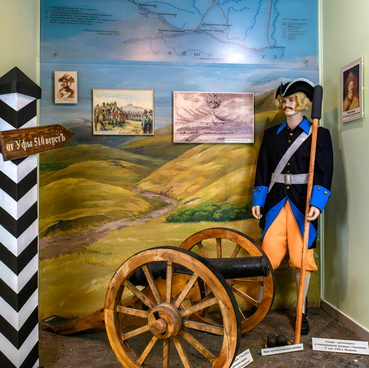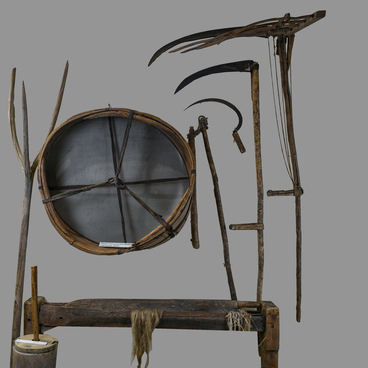On 6 August 1735, historian Ivan Kirilov’s expedition reached a mountain which later earnt the name Mount Preobrazhenskaya. On 15 August, the western wall of the First Orenburg (later Orsk) fortress was triumphantly formed in the mountain “from cannon fire”. The moment of Orenburg’s foundation at the mouth of the river Ori is reflected in Valentin Pikul’s novel “Slovo i Delo”. Pikul demonstrated the subjectivity of the decision about the city’s translocation to its second location by the fact that the city was moved again under Neplyuev. This was the location of a ‘village of miserable existence’, whilst Kirilov’s preferred location was one where “life could never fade away”. He “properly built a city in a good place and now an industrial giant resides there - called Orsk! ”
The original fortress wasn”t too large (around 300×250 meters), rectangular in shape, surrounded by a two meter deep moat and ramparts with bastions at each corner. The rampart contained two gates (in the north and south), with a wattle fence running along its edge. Canons were placed in the bastions. Saint Andrew”s church was situated in the center (on the site of the Industrial College).
The original fortress wasn”t too large (around 300×250 meters), rectangular in shape, surrounded by a two meter deep moat and ramparts with bastions at each corner. The rampart contained two gates (in the north and south), with a wattle fence running along its edge. Canons were placed in the bastions. Saint Andrew”s church was situated in the center (on the site of the Industrial College).
A wooden citadel with stockade was built on Mount Preobrazhenskaya. In 1742, under the chief of the Orenburg region, Ivan Neplyuev, the citadel was expanded and surrounded by a three meter tall rampart, with four bastions and two half-bastions. This new fortification was called the Preobrazhenskaya castle.
The Yaik (Ural) flood in 1749 destroyed almost all of the fortress” buildings, including the church. The residents “were barely able to flee with their most treasured belongings.” After this, construction was transferred to a new site next to the mountain. By 1751, a new “half-stone” Preobrazhenskaya church rather than a citadel was completed.
It is noteworthy that in the writing of famous traveler Peter Simon Pallas, Mount Preobrazhenskaya is referred to as “Aspidnaya”, from the Latin word for Jasper.
The Yaik (Ural) flood in 1749 destroyed almost all of the fortress” buildings, including the church. The residents “were barely able to flee with their most treasured belongings.” After this, construction was transferred to a new site next to the mountain. By 1751, a new “half-stone” Preobrazhenskaya church rather than a citadel was completed.
It is noteworthy that in the writing of famous traveler Peter Simon Pallas, Mount Preobrazhenskaya is referred to as “Aspidnaya”, from the Latin word for Jasper.
Between the second half of the 18th century and the beginning of the 19th century a fair number of scientists and researchers visited the fortress. Astronomer Christopher Euler, son of famous mathematician Leonard Euler, observed Venus’s eclipse of the Sun between 23 May and 3 June 1769 from a temporary observatory on Mount Preobrazhenskaya, following the instructions of the Saint Petersburg Academy of Sciences. German traveler and Russian academic Pallas stayed at the Orsk Fortress on 13 (24) July 1769. In 1829, German scientist Alexander Humboldt visited the fortress.
In the summer of 1837, whilst travelling around Russia, Tsarevich Alexander Nikolaevich Romanov stayed at the Orsk Fortress. He was the future ‘tsar-liberator’, Alexander II. He was accompanied by his mentor Vasily Zhukovsky. Zhukovsky only left a few words about this stay in his notes: ‘We dined in the Orsk fortress.’ However his drawing of the Preobrazhenskaya mountain and the church was preserved.
In the summer of 1837, whilst travelling around Russia, Tsarevich Alexander Nikolaevich Romanov stayed at the Orsk Fortress. He was the future ‘tsar-liberator’, Alexander II. He was accompanied by his mentor Vasily Zhukovsky. Zhukovsky only left a few words about this stay in his notes: ‘We dined in the Orsk fortress.’ However his drawing of the Preobrazhenskaya mountain and the church was preserved.

